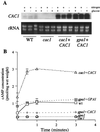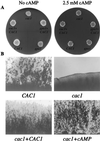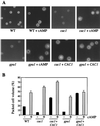Adenylyl cyclase functions downstream of the Galpha protein Gpa1 and controls mating and pathogenicity of Cryptococcus neoformans
- PMID: 12455973
- PMCID: PMC118042
- DOI: 10.1128/EC.1.1.75-84.2002
Adenylyl cyclase functions downstream of the Galpha protein Gpa1 and controls mating and pathogenicity of Cryptococcus neoformans
Abstract
The signaling molecule cyclic AMP (cAMP) is a ubiquitous second messenger that enables cells to detect and respond to extracellular signals. cAMP is generated by the enzyme adenylyl cyclase, which is activated or inhibited by the Galpha subunits of heterotrimeric G proteins in response to ligand-activated G-protein-coupled receptors. Here we identified the unique gene (CAC1) encoding adenylyl cyclase in the opportunistic fungal pathogen Cryptococcus neoformans. The CAC1 gene was disrupted by transformation and homologous recombination. In stark contrast to the situation for Saccharomyces cerevisiae, in which adenylyl cyclase is essential, C. neoformans cac1 mutant strains were viable and had no vegetative growth defect. Furthermore, cac1 mutants maintained the yeast-like morphology of wild-type cells, in contrast to the constitutively filamentous phenotype found upon the loss of adenylyl cyclase in another basidiomycete pathogen, Ustilago maydis. Like C. neoformans mutants lacking the Galpha protein Gpal, cac1 mutants were mating defective and failed to produce two inducible virulence factors: capsule and melanin. As a consequence, cac1 mutant strains were avirulent in animal models of cryptococcal meningitis. Reintroduction of the wild-type CAC1 gene or the addition of exogenous cAMP suppressed cac1 mutant phenotypes. Moreover, the overexpression of adenylyl cyclase restored mating and virulence factor production in gpal mutant strains. Physiological studies revealed that the Galpha protein Gpa1 and adenylyl cyclase controlled cAMP production in response to glucose, and no cAMP was detectable in extracts from cac1 or gpa1 mutant strains. These findings provide direct evidence that Gpal and adenylyl cyclase function in a conserved signal transduction pathway controlling cAMP production, hyphal differentiation, and virulence of this human fungal pathogen.
Figures





References
-
- Alspaugh, J. A., L. M. Cavallo, J. R. Perfect, and J. Heitman. 2000. RAS1 regulates filamentation, mating and growth at high temperature of Cryptococcus neoformans. Mol. Microbiol. 36: 352–365. - PubMed
-
- Alspaugh, J. A., R. C. Davidson, and J. Heitman. 2000. Morphogenesis of Cryptococcus neoformans. Contrib. Microbiol. 5: 217–238. - PubMed
-
- Alspaugh, J. A., J. R. Perfect, and J. Heitman. 1998. Signal transduction pathways regulating differentiation and pathogenicity of Cryptococcus neoformans. Fungal Genet. Biol. 25: 1–14. - PubMed
-
- Borges-Walmsley, M. I., and A. R. Walmsley. 2000. cAMP signalling in pathogenic fungi: control of dimorphic switching and pathogenicity. Trends Microbiol. 8: 133–141. - PubMed
Publication types
MeSH terms
Substances
Grants and funding
- R37 AI039115/AI/NIAID NIH HHS/United States
- R56 AI028388/AI/NIAID NIH HHS/United States
- R01 AI042159/AI/NIAID NIH HHS/United States
- R01 AI42159/AI/NIAID NIH HHS/United States
- R01 AI028388/AI/NIAID NIH HHS/United States
- R01 AI039115/AI/NIAID NIH HHS/United States
- R01 AI41937/AI/NIAID NIH HHS/United States
- R01 AI39115/AI/NIAID NIH HHS/United States
- P01 AI44975/AI/NIAID NIH HHS/United States
- K08 AI01556/AI/NIAID NIH HHS/United States
- R01 AI28388/AI/NIAID NIH HHS/United States
- P01 AI044975/AI/NIAID NIH HHS/United States
LinkOut - more resources
Full Text Sources
Molecular Biology Databases
Research Materials

